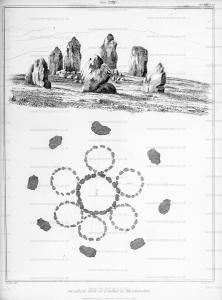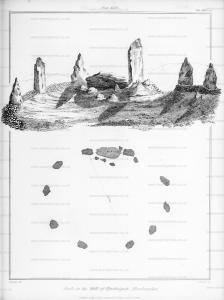Archaeologia Volume 22 Appendix
Archaeologia Volume 22 Appendix is in Archaeologia Volume 22.
March 28, 1822. James Logan, Esq. communicated to the Society two Drawings of Druidical Circles in Aberdeenshire, accompanied by some Remarks.

"Circles," he observes, "although generally referred to the sera of the Druids, were not exclusively devoted to the rites of Bardism; and the antiquity of some may be doubted. Pinkerton in his 'Inquiry' into the History of Scotland,' remarks, on the authority of Caesar (who says the Germans had no Druids), that the system was a late invention, and was abolished by Tiberius. It is however certain that in some cases we have proofs of their having been constructed prior to the Roman invasion, since, in several instances they are traversed by Roman Roads. Borlase, in his 'Antiquities of Cornwall,' states that the number of stones was determined by certain established rules; and King, in his 'Munimenta Antiqua' thought, from the arrangement of many of them, that there was good reason for suspecting them to have been used as rude astronomical instruments. We are told by another writer, that grand meetings were held in them at the Solstices and Equinoxes.
Circles were used among the Northern nations for the assemblage of the people at the election of their Princes. Eric King of Sweden was elected at a celebrated monument of this kind at Upsal in 1396.
Many of these remains, attributed to the Druids, were Gothic Courts of Justice. It has been observed, indeed, that they served the double purpose of Temples and Courts, the characters of Judge and Priest being often united in one person. Barry, in his 'History of the Orkney Islands,' inserts an extract from £ Island's Landnaina bok,' where it is said, * a judicial circle stands there, where men were doomed to sacrifice - there Thorder Galler erected a court for one quarter, by the consent of all the men of that quarter.' So late as 1380, a regality Court was held in Scotland at the 'standard stanes' of Kingusie.
"Another use to which circles were appropriated was for Trial by Combat; but it seems probable that they were chiefly devoted to religious purposes. Great veneration was undoubtedly attached to them, and the ponderous masses inspired awe when their original destination became unknown. Many churches have been built in or near the site of Druidical Temples; several instances of which I have remarked in Scotland: and in the Highlands, to this day, the word Clachan signifies both a circle of stones and a place of worship.
"The First of the accompanying Drawings presents a South View of a singular Monument at Leuchar [Cullerlie Stone Circle [Map]], in the parish of Skene, in Aberdeenshire.b It is situated upon an extensive moor from which turf is cut. From this circumstance it is denominated a Moss, and the appellation Leuchar, seems to be the Gaelic Leu - chra, reedy or abounding in rushes. The Circle is of small dimensions, and the largest stone does not exceed six feet in height. The diameter of the Circle is thirty-four feet. The small Circles contained in the larger present a curious singularity; and it is also remarkable that, at a short distance to the southwest, are nine others of similar dimensions. About a hundred feet south-east is a Cairn; and on a hill in the back-ground is seen another.
Note b. Plate XXXIV.

"The Second Drawing presents a View from the interior of a Circle on the hill of Tyrbagger [Tyrebagger Stone Circle [Map]] in the same County.c The name is compounded of the Gaelic words Tyr, land, and Bachar, an acorn; an appellation which may possibly have arisen from the abundance of Oak-trees, which were always attendant on sacred Circles.
"This second Circle consists of ten upright stones, the largest of which is on the south side. It is between ten and eleven feet in height, and is eleven feet in circumference at the base. Beside it is another, eleven feet in length, which, although now prostrate, has originally been elevated on several smaller stones. The diameter of this Circle, from north to south, is fifty-seven feet; and the area has been at one time appropriated for the reception of cattle belonging to the inhabitants of an adjacent cottage, now in ruins; for this purpose it has been hollowed beneath the level of the surrounding soil. The View presents a distant prospect of the hill of Drum min, on the summit of which is seen a Stone of Memorial, and, still more distant, on the same ridge, a sepulchral Cairn."
Note c. Plate XXXV.
